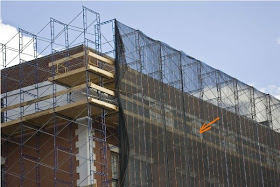
Photo-Francois Portmann www.fotoportmann.com/
Photographer and hawk watcher Francois Portmann hiked over to PS 188 with his camera and took these shots of the scaffolding on the building.

Photo by Francois Portmann
And here is the accompanying note:
Donna,
Here are pix of ps188. The nest is still there and the netting is open on top but that’s not enough!I keep seeing what seems to be that same female Red-tailed Hawk around here, (Francois’ neighborhood not the banded PS188 formel. D.B.) no sight of the 2nd.
She is regularly harassed by crows (btw, a good indication that rth are around)
Latr’
Francois

Photo by Francois Portmann
I did forget to add Crows to my list of bird species who love to mob Red-tails in yesterday's post, didn't I? A definite oversight as Crows just can't wait to go after a hawk. In fact they are often how I find the Cooper's and Sharpies who predate my feeders in Wisconsin.
NOW TO THE TOPIC OF THE CHELSEA RED-TAIL OR RED-TAILS--

Chelsea Grid Map Courtesy of www.notbored.org/
(They do walking tours and count the number of surveillance cameras in various neighborhoods. You never know what you're going to find on the Internet. I wonder if we could get the people who get the feeds for all those cameras to hawkwatch? That's a joke, unfortunately.)
Yesterday, Brett Odom sent in a sighting of a Red-tailed Hawk in Chelsea (a neighborhood in Manhattan) and I asked for other sightings. Bingo, in came one from Chelsea resident birdwatchers, Elisabeth and James.
Hi there,Just spotted a Red-tail arguing with a local Blue Jay family! We stepped out onto our balcony for a moment and heard the Jays bickering then were treated to a hawk swooping just in front of us in the space between our building and the buildings across from us! We are located in Chelsea between 7th and 8th Avenue and 20th and 21st St. So perhaps there is a nest in Chelsea?
Happy Birding!
Elisabeth and James
Many thanks for the sighting! Did either of you happen to notice if this hawk was mature or a brown-tail? Keep us posted! Just click on the Contact Me button in the right column of the main page to email.

And now to Mixed Flock Dynamics--
Today's group of ground feeders were the Wisconsin big three after the snow starts to fly: Mourning Doves, Dark-eyed Juncos, House Sparrows.
Now the House Sparrows are, how can I say it? Well, the House Sparrows are just downright flighty. Every ten or twenty seconds on a particularly nervous day like today, they take off for their brush pile to hide due to what seems like invisible provocation most of the time to the other two species who look around for a few seconds and then tend to stay put, and keep foraging.
Not that some of the Mourning Doves don't have flighty moments themselves. The dove in the photo is Doorstep Dove who knows me quite well and isn't bothered if there is movement beyond the glass door. Earlier she'd flown in by herself, and after about ten minutes of not being eaten by anything, the rest of the flock of seven doves came in to forage as well.
Unfortunately for them, after several hysterical flights by the House Sparrows back and forth, the other Mourning Doves eventually became so rattled that they flew off with the sparrows, though they weren't so quick to return.

So when the mixed flock congregated once again it was just Doorstep with the sparrows, and the Juncos.

Then whatever it was set the sparrows off once again, and Doorstep as well. Notice how they stay low and fly beside cover, the house and the planter. The sparrow will fly into the brush pile which is about 10 feet away and Doorstep once past the glider will hug the house for a few feet and then curve quickly gaining altitude and fly into the Maple that overhangs the area.
Notice that the Juncos are looking but haven't taken to their wings. At this time of day, had they decided that there was danger they would likely have gone into the "Junco Freeze". They would have stayed on the ground completely still until the alert was over.
Why the hawks don't see their little dark birdie shapes against the snow, I don't know. But the Junco Freeze seems to work.

Having had enough to eat and likely enough of the nervous House Sparrows, Doorstep takes up her evening position on the warmed birdbath, often facing where the sunset ought to be. This evening there is no light show. Yet again the snow clouds have rolled in and as of now, the snow is falling heavily.
Donegal Browne




































